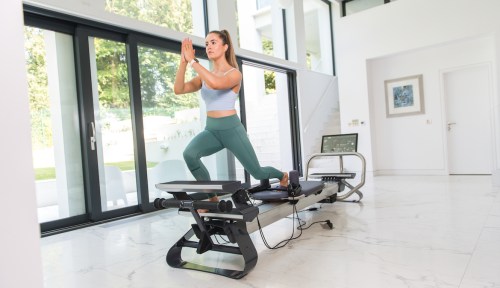Our editors independently select these products. Making a purchase through our links may earn Well+Good a commission
Smart, Connected Pilates Reformers Are Here. But Are They Worth the Price?
Megaformers and reformers with virtual classes you can do from home have arrived. But these smart pilates reformers cost a pretty penny.

If you’ve managed to avoid dropping stacks of cash on building out a home workout setup over the last few pandemic years, kudos. Many people have invested thousands of dollars into exercise equipment, like Pelotons (which some have ended up using more than others). But a new class of luxury at-home fitness machines is here, and it might take the high-priced cake.
Experts in This Article
Enter: At-home, “smart” or “connected” Pilates reformers.
Reformers have been available for individuals to purchase almost as long as they’ve been around, and there are now more compact, lower-priced options than ever before. But these reformers are something different—they’re the “Peloton-ification” of Pilates. And they cost around $2,000 to $5,000, plus a monthly subscription fee for access to on-demand classes.
Multiple brands have recently come out with reformers meant to be used in tandem with guided virtual workouts. The idea is that you’ll be able to do reformer Pilates classes—and not just use your machine free-style—from the comfort of your home gym.
What smart reformers offer
What makes these machines “smart” or “connected” varies from brand to brand. Reform RX’s reformer comes with a screen pre-loaded with a library of classes and adjustable settings. The spine of the reformer also measures your reps and the force of your output, and you can see your stats both immediately and over time. Frame’s sleek pink reformer comes with a screen and content library, but no smart biofeedback. Flexia has no attached screen, but it does measure your resistance, and will give you setting adjustment recommendations in its app (where it also has its streaming class library).
Pilates instructor Amy Jordan, the founder of WundaBar Pilates, is enthusiastic that these machines could bring Pilates to people who might not have the opportunity to go to a reformer-equipped studio.
“Those of us who live in New York or Los Angeles, we’re just like, well, why wouldn’t you just go down the street?” Jordan says. “But for millions and millions of people that just isn’t even an option. There’s nothing like that where they live.”
But physical access is not the same as making something accessible, especially since these machines cost thousands of dollars. The Flexia is currently discounted from $3,495 to $2,995, and Frame (the pink one!) is $3,999, and Reform RX will run you $4,995—nearly three and a half times the price tag of a base model Peloton bike. All three also require a $39 monthly subscription fee to have access to the content libraries.
Lagree Fitness—the brand refers to itself as “Pilates on steroids”—sells home megaformer-like machines called the Micro (starting at $990) and Mini (starting at $2490) that pair with its streaming classes. You’ll also pay $9.99 a month for access to the celeb-approved workout.
The benefits and downsides of at-home access
So is convenient access to an admittedly awesome workout worth the price? Heather Andersen, the founder and owner of New York Pilates, appreciates that the machines might “be a great resource for students interested in the quantitative results of a workout.” Personally, when I tried the Reform RX, I did not find the stats that compelling or motivating, but that might change if you have a trends line you can look at over time.
However, Andersen also notes that at-home machines might not “provide the support that you can receive through an in-person class.” New York Pilates offers an online streaming platform, but Andersen says “we highly encourage in-studio classes. There’s nowhere else that you can get the hands-on instruction, form corrections, and individualized support.”
Form is important for every workout, but especially so in Pilates. Engaging your Pilates core is a very specific exercise that can be difficult to understand without the help of a teacher, at least the first time. Ditto for the form you have to maintain in Pilates staple positions like the neutral spine and tabletop legs.
“Pilates can be so confounding,” Jordan says. So while she is enthusiastic about the machines, she recommends making sure you have the basics down first.
She also stresses the importance of paying attention to your body’s physical cues. “Make sure that you’re not just trying to kind of push through any moves,” Jordan says. “When you’re in person, I’m going to notice that you’re favoring your hip, or that your face is kind of wincing when we’re doing something, and I will attend to that. So it’s really up to you, the user at home, to advocate for yourself. And if something doesn’t feel great to stop doing it.”
Still, there are some unexpected potential upsides. Reform RX features classes for beginners, intermediate, and advanced. Reform RX instructor Kourtney McCullough explains that most Pilates studios aren’t able to offer segmented classes like these, since the goal is to fill every spot. She appreciates being able to program her classes to the level she is teaching.
“Exercise selection in Pilates classes varies drastically depending on the client’s level of experience,” McCullough says. “I love knowing that regardless of whether I’m programming for a beginner or an expert, every user will get a thoughtful class that will give them a safe, but extremely effective, workout every time.”
The level of attention a student gets from a teacher can also really vary from class to class. If you’re having an issue with a move, the teacher might not have time after class to break it down for you. After doing a Reform RX class, I was a bit confused about one of the segments—which was complicated a bit by the fact that I wasn’t facing the screen for that move, so I couldn’t actually see what the teacher was doing. However, the content library has step-by-step instructional modules for every move they feature. So once I was done with the workout, I got to practice the move. I also could have had the option during class to simply pause and rewind—definitely not something you can do in person.
Applying the Peloton virtual class model to reformer Pilates may have been inevitable. And just like with cycling, rowing, running, or lifting, it has the pros of on-demand ease of use, and the cons of no in-person instruction and camaraderie. What makes this modality different is the giant price tag on the equipment itself. But if you want the core-quaking, muscle-stabilizing workout of machine Pilates classes from the comfort of home, and you have a few thousand dollars on hand, at least now you’ve got options.
Sign Up for Our Daily Newsletter
Get all the latest in wellness, trends, food, fitness, beauty, and more delivered right to your inbox.
Got it, you've been added to our email list.










